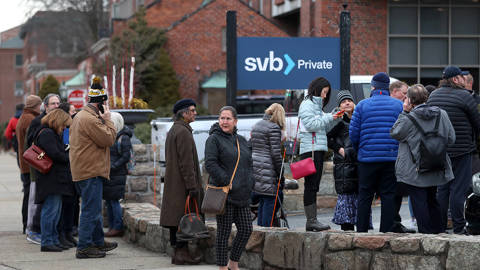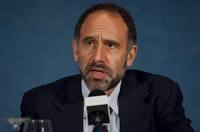ar 13, 2023
The collapse of Silicon Valley Bank is emblematic of deep failures in the conduct of both regulatory and monetary policy. Will those who helped create this mess play a constructive role in minimizing the damage, and will all of us – bankers, investors, policymakers, and the public – finally learn the right lessons?
NEW YORK – The run on Silicon Valley Bank (SVB) – on which nearly half of all venture-backed tech start-ups in the United States depend – is in part a rerun of a familiar story, but it’s more than that. Once again, economic policy and financial regulation has proven inadequate.
2
Lessons from the SVB Coll
The news about the second-biggest bank failure in US history came just days after Federal Reserve Chair Jerome Powell assured Congress that the financial condition of America’s banks was sound. But the timing should not be surprising. Given the large and rapid increases in interest rates Powell engineered – probably the most significant since former Fed Chair Paul Volcker’s interest-rate hikes of 40 years ago – it was predicted that dramatic movements in the prices of financial assets would cause trauma somewhere in the financial system.
But, again, Powell assured us not to worry – despite abundant historical experience indicating that we should be worried. Powell was part of former President Donald Trump’s regulatory team that worked to weaken the Dodd-Frank bank regulations enacted after the 2008 financial meltdown, in order to free “smaller” banks from the standards applied to the largest, systemically important, banks. By the standards of Citibank, SVB is small. But it’s not small in the lives of the millions who depend on it.
Powell said that there would be pain as the Fed relentlessly raised interest rates – not for him or many of his friends in private capital, who reportedly were planning to make a killing as they hoped to sweep in to buy uninsured deposits in SVB at 50-60 cents on the dollar, before the government made it clear that these depositors would be protected. The worst pain would be reserved for members of marginalized and vulnerable groups, like young nonwhite males. Their unemployment rate is typically four times the national average, so an increase from 3.6% to 5% translates into an increase from something like 15% to 20% for them. He blithely calls for such unemployment increases (falsely claiming that they are necessary to bring down the inflation rate) with nary an appeal for assistance, or even a mention of the long-term costs.1
Now, as a result of Powell’s callous – and totally unnecessary – advocacy of pain, we have a new set of victims, and America’s most dynamic sector and region will be put on hold. Silicon Valley’s start-up entrepreneurs, often young, thought the government was doing its job, so they focused on innovation, not on checking their bank’s balance sheet daily – which in any case they couldn’t have done. (Full disclosure: my daughter, the CEO of an education startup, is one of those dynamic entrepreneurs.)
While new technologies haven’t changed the fundamentals of banking, they have increased the risk of bank runs. It is much easier to withdraw funds than it once was, and social media turbocharges rumors that may spur a wave of simultaneous withdrawals (though SVB reportedly simply didn’t respond to orders to transfer money out, creating what may be a legal nightmare). Reportedly, SVB’s downfall wasn’t due to the kind of bad lending practices that led to the 2008 crisis and that represent a fundamental failure in banks performing their central role in credit allocation. Rather, it was more prosaic: all banks engage in “maturity transformation,” making short-term deposits available for long-term investment. SVB had bought long-term bonds, exposing the institution to risks when yield curves changed dramatically.
New technology also makes the old $250,000 limit on federal deposit insurance absurd: some firms engage in regulatory arbitrage by scattering funds over a large number of banks. It’s insane to reward them at the expense of those who trusted regulators to do their job. What does it say about a country when those who work hard and introduce new products that people want are brought down simply because the banking system fails them? A safe and sound banking system is a sine qua non of a modern economy, and yet America’s is not exactly inspiring confidence.
As Barry Ritholtz tweeted, “Just as there are no atheists in Fox Holes, there are also no Libertarians during a financial crisis.” A host of crusaders against government rules and regulations suddenly became champions of a government bailout of SVB, just as the financiers and policymakers who engineered the massive deregulation that led to the 2008 crisis called for bailing out those who caused it. (Lawrence Summers, who led the financial deregulation charge as US Treasury Secretary under President Bill Clinton, also called for a bailout of SVB – all the more remarkable after he took a strong stance against helping students with their debt burdens.)1
The answer now is the same as it was 15 years ago. The shareholders and bondholders, who benefited from the firm’s risky behavior, should bear the consequences. But SVB’s depositors – firms and households that trusted regulators to do their job, as they repeatedly reassured the public they were doing – should be made whole, whether above or below the $250,000 “insured” amount.
To do otherwise would cause long-term damage to one of America’s most vibrant economic sectors; whatever one thinks of Big Tech, innovation must continue, including in areas such as green tech and education. More broadly, doing nothing would send a dangerous message to the public: The only way to be sure your money is protected is to put it in the systemically important “too big to fail” banks. This would result in even greater market concentration – and less innovation – in the US financial system.
After an anguishing weekend for those potentially affected throughout the country, the government finally did the right thing – it guaranteed that all depositors would be made whole, preventing a bank run that could have disrupted the economy. At the same time, the events made clear that something was wrong with the system.
Some will say that bailing out SVB’s depositors will lead to “moral hazard.” That is nonsense. Banks’ bondholders and shareholders are still at risk if they don’t oversee managers properly. Ordinary depositors are not supposed to be managing bank risk; they should be able to rely on our regulatory system to ensure that if an institution calls itself a bank, it has the financial wherewithal to pay back what is put into it.
SVB represents more than the failure of a single bank. It is emblematic of deep failures in the conduct of both regulatory and monetary policy. Like the 2008 crisis, it was predictable and predicted. Let’s hope that those who helped create this mess can play a constructive role in minimizing the damage, and that this time, all of us – bankers, investors, policymakers, and the public – will finally learn the right lessons. We need stricter regulation, to ensure that all banks are safe. All bank deposits should be insured. And the costs should be borne by those who benefit the most: wealthy individuals and corporations, and those who rely most on the banking system, based on deposits, transactions, and other relevant metrics.
It has been more than 115 years since the panic of 1907, which led to the establishment of the Federal Reserve System. New technologies have made panics and bank runs easier. But the consequences can be even more severe. It’s time our framework of policymaking and regulation responds.








